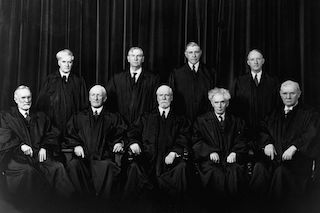Official Transcripts
The Supreme Court Library recently digitized all its “official” transcripts for cases argued since October 1968, which we have catalogued and matched against the Supreme Court Database.
Prior to October 1968, the Supreme Court did not regularly commission transcripts, except when the Court deemed it appropriate. For example, all the oral arguments in Brown v. Board of Education (I) and Brown v. Board of Education (II) were fully transcribed.
In even older cases, you’ll occasionally find transcripts of arguments recorded in U.S. Reports. Norman v. Baltimore & Ohio R. Co. is one such case. It records the “arguments” of the attorneys for both Norman and the Baltimore & Ohio Railroad Company, as well as the “oral argument” of Attorney General Cummings, along with the following footnote:
Mr. Cummings’ address, stenographically reported, has been printed in full by the Government Printing Office. Omissions from the present report are marked by dots. He also closed the argument in all of the cases.
The U.S. Reports volume makes clear that the “arguments” were simply extracted from the briefs, whereas the “oral argument” was more like a conventional transcript – except that it was edited, which severely compromises it as a record. Fortunately, a transcript “printed in full” presumably exists somewhere, and we can hope that someday all such “stenographically reported” documents will become available online.
See our post on The Supreme Court Library for further discussion.
Note Regarding Speakers
You may notice that transcripts produced by the U.S. Supreme Court from October Term 1968 through October Term 2003 intentionally withheld the names of the Justices who spoke during oral argument. Instead of a name, transcripts would use “Q” or “QUESTION” to indicate a question or other interjection from a Justice.
This policy was established by Chief Justice Earl Warren, perhaps to create the illusion that the Court spoke with one voice, but it’s unclear exactly when the practice was adopted, since the Court did not routinely produce official transcripts until October Term 1968. However, it seems likely that both practices changed at the same time, because we have a copy of the official transcript of the reargument of Time v. Hill from October 18, 1966, and all Justices are identified.
Also, one should not assume that any transcript prior to 1968 is an “official” transcript, because most transcripts from 1955 to 1968 usually came from either the University Publications of America (UPA) microfiche collection or the Landmark Briefs and Arguments (LBA) series, and those were simply recreated by transcribing the audio recordings made during that period. So in those cases, the lack of speaker names is a question of the editor’s effort, not Court policy.
The policy was finally abandoned by Chief Justice William Rehnquist, beginning October Term 2004.
Unofficial Transcripts
Prior to October Term 1968, you can find unofficial transcripts of cases from the Warren Court in the aforementioned University Publications of America (UPA) microfiche collection. Selected transcripts from even older cases can also be found in the Landmark Briefs and Arguments (LBA) series; unfortunately, LBA transcripts were re-transcribed and reformatted for publication, so it’s impossible to make any assessment of their accuracy or provenance.
All oral arguments in the U.S. Supreme Court cases from October 1955 onward were recorded by the Court on reel-to-reel tape and subsequently deposited at the National Archives, which The Oyez Project finished digitizing and transcribing several years ago, so with only a few exceptions (i.e., where the recording was lost, damaged, or incomplete), unofficial transcripts can be obtained from their website for all such cases.
Advantages of the Oyez transcripts include: synchronization with the audio, live playback, searching and clipping functionality, and identification of previously unidentified Justices. So, while the Oyez transcripts must be considered “unofficial,” they are actually easier to use and verify than even the Court’s own transcripts.
Unfortunately, there are a few (extremely rare) caveats regarding the authenticity of transcripts derived from audio: instances where the recording equipment failed, and where the Court “edited” the audio recording before sending it to the National Archives (eg, to remove a public outburst in the courtroom).
One apparent example of the latter is Octane Fitness v. ICON Health & Fitness, where an outburst occurred roughly 49 minutes into the argument, but both the outburst and Justice Kennedy’s comments (“Take your time, take your time.”) are missing from the recording. I’m unaware of the Court ever confirming or denying this practice, but if true, it’s regrettable that the Court would prioritize vanity and decorum over the historical accuracy of what actually transpired.
There may have even been instances where someone at the Court “edited” (or considered editing) audio recordings after they had been delivered to the National Archives. See About That Keeton v. Hustler Recording.
